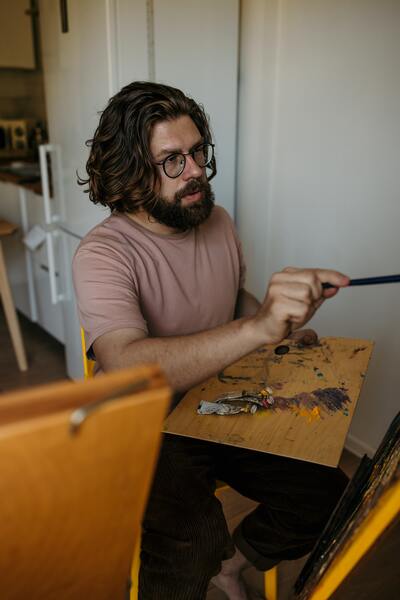Art therapists and art psychotherapists are trained professionals who use art as a form of psychotherapy. Anyone can benefit from it, not just those whose lives have been negatively impacted by trauma, sickness, or handicap.
Why is Art Therapy Needed?
Patients in art therapy use their creations to help them cope with their feelings about their experiences and find the words to describe how they’ve been impacted.
Adversity can affect our well-being, but it can be hard to express how we feel about it. That allows art therapists to engage clients who had previously been excluded from traditional conversation therapy. Art therapy thus aids in preventing anyone from falling through the cracks.
Who is Art Therapy Suitable for?
Any person of any age or cultural background can benefit from engaging in art therapy (infants and parents, children, young people, adults, and older people). Anyone curious about what can come from freeing one’s imagination can participate; participants need not be artists.
How is Art Therapy Regulated?
In the United Kingdom (UK), becoming an art therapist or art psychotherapist requires the completion of a training program recognized by the Health and Care Professions Council (HCPC). The Health and Care Professions Council also keeps a database of certified art therapists.
Art Therapy Techniques
As a form of psychotherapy, art therapy seeks to aid its patients by encouraging them to express themselves creatively to discover new avenues of self-exploration, insight, and coping.
People often turn to art to process their feelings, learn about themselves, deal with difficult situations, build confidence, and expand their circle of friends.
Art therapy can use various mediums and methods, such as:
- Coloring
- Collage
- Doodling/scribbling
- Finger painting
- Drawing
- Painting
- Clay work
- Photography
- Sculpture
Clients may reflect on their artwork and how it makes them feel as they are creating it. People can get insight into the themes and conflicts influencing their ideas, emotions, and behaviors by examining the art they have created.
What Art Therapy Can Help With?
A wide variety of emotional and mental problems responds well to art therapy. It’s possible to utilize it in conjunction with other forms of psychotherapy, such as CBT or group therapy (CBT).
Art therapy is effective in treating a variety of diseases, including:
- Anger problems
- Anxiety
- Depression
- Cancer
- Eating disorders
- Medical issues
- Emotional distress
- Stress
- Relationship or family strife
- Marital issues
- Psychological symptoms related to other medical problems
- Substance abuse disorders
- Psychological problems
Benefits of Art Therapy
The therapeutic potential of art lies in its ability to provide a source of pleasure. Having a safe space to let out your feelings and thoughts can do wonders for your emotional and mental well-being.
Art therapy is an effective method for treating a wide variety of medical conditions in both children and adults.
It’s easy for some people to feel helpless in the face of so many challenges; they may feel unable to keep up with life’s constant demands. With art therapy, you can take a breather and focus on making progress toward the following goals:
- Self-expression and expression of feelings
- When words fail you, your work can be a window into your inner world, allowing you to explore and express feelings that may be difficult to put into words.
- Recognizing your growth and inner strength
- Through art, one can express their innermost thoughts and emotions.
- Coming to terms with physical illness
Art therapy can be helpful for people with chronic and life-limiting illnesses who are trying to cope with the emotional and psychological toll that their condition has taken on their lives.
What to Expect from Art Therapy
The first step in any therapy is to meet with the therapist and discuss your reasons for seeking assistance and the services they can provide. You and your group will develop a treatment strategy that includes making art.
Sometimes the therapist will watch you work without offering advice or making any comments.
The therapist will ask you questions about how you feel, about the artistic process, what was easy or difficult about producing your artwork, and what thoughts or recollections you may have had while you were working.
This is after you have finished a piece of artwork while still working on it. A therapist would often inquire about your feelings and experiences before making judgments or recommendations.
Art therapists employ a wide range of interventions; their flexibility and resourcefulness allow them to modify their methods based on the needs of each particular client.
Art therapists use a wide variety of tools and approaches. An art therapist might have a client create a clay representation of a loved one, have them make a collage out of photos, or have them write about their thoughts and feelings about a piece of art.
What to look for in Art Therapist?
Art therapists have a master’s degree, at the very least, typically earned through a combined program in psychotherapy and the visual arts at a school recognized by the Council for Higher Education Accreditation (CHEA).
After a therapist’s name, you’ll see the letters ATR, which stands for “Art Therapy Credentials Board Registered” (ATCB). If a therapist’s initials are ATR-BC, it signifies they are both registered with the ATR and have passed the ATCB’s certification exam.
Finding a therapist you can trust is also essential. Before starting therapy with a new provider, you may have questions you want to ask them.
This article looks at the benefits of art therapy. Learning art therapy skills is one of the important skills for self development. Find out about the other self development skills you can benefit from improving.






